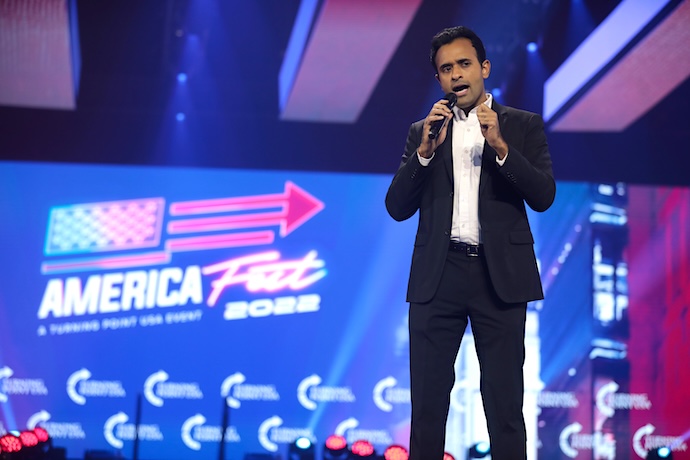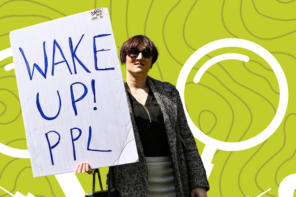Vivek Ramaswamy’s candidacy for the Republican Presidential nomination might seem idiosyncratic and incoherent, but it marks the most recent manifestation of a process long underway: the convergence of Hindu supremacy and White supremacy in the United States. With this convergence comes the looming possibility that large segments of the wealthiest, fastest-growing immigrant community could move squarely into the Far Right.
Open alliances between Hindu supremacy and White supremacy have not been new. During their tenures in office, President Trump and Indian PM Narendra Modi based their close personal relationship around the deep overlaps between their respective political projects—and, one could add, their cults of personality. These were epitomized by two massive showpiece events within the space of a year: the Howdy Modi rally in September 2019, and the Namaste Trump event that followed in February 2020, where each leader in turn offered a hearty public endorsement of his counterpart.
But the Trump-Modi bonhomie, as splashy a media spectacle as it was, ultimately remained understood as an alliance between two leaders in two distinct locations, pursuing their own similar but ultimately separate political projects. For U.S. audiences, one remained frighteningly proximate, the other illegibly distant, and downplayed by a geopolitical paradigm that has sought to uphold India as a counterweight to China. (This summer, Modi was given just as warm a welcome by President Biden, whose Secretary of Commerce Gina Raimondo went out of her way to praise as “unbelievable, visionary.”)
But, while Modi represents the high-water mark of Hindu supremacist power in India, the political convergence between the two movements—epitomized by Ramaswamy, but extending well beyond him—signals something quite different: that Hindu supremacy, as it manifests in the U.S., is becoming a key ally of White supremacy.
It might well be the transnational nature of Hindu supremacy that demonstrates the short-sightedness of U.S. geopolitical strategy. As Hindu supremacy has taken root on Western shores, its influence is becoming tougher to ignore. In Edison, New Jersey, Hindu far-right groups paraded bulldozers, a symbol of anti-Muslim oppression. In Sydney, Australia, they attacked Sikhs; while in Leicester, UK, Hindu supremacist marches precipitated Hindu-Muslim riots. Hindu supremacists have fiercely opposed civil rights protections around caste, free speech and affirmative action, and spread waves of disinformation and anti-Muslim hate speech, including most recently against Palestinians.
Nevertheless, we have continued to understand Hindu supremacy as a diasporic project imported by immigration, consisting primarily of U.S.-based actors who support, lobby for, finance, and otherwise find common cause with, a movement seeking to establish the absolute political hegemony of Hindus in India. This is a crucial framework for understanding the global infrastructure that powers Hindu supremacy, but it leaves unanswered an adjacent question: What precise form does this project take in the U.S. itself, where its main progenitors actually live and work, and where Hindus—and indeed all South Asians—remain a minority?
Collapse of the ‘Modi Democrat’
For a while, the answer to this question was clear, though it held contradictions within it. Many of those sympathetic to Hindu supremacist politics fit into the category of the “Modi Democrat,” a contradiction characterized by enthusiastic support for a violent, ethno-nationalist regime in India, held alongside a keen awareness of, and concern for, their own precarity as minorities in the U.S., with its own far-right ethno-nationalist project to contend with—one that would not be in their favor.
But this category has always been inherently unstable. As the Modi Democrat bought into a politics of anguished victimhood that made permissible and even necessary the rewriting of textbooks in California to remove references to caste, spread anti-Muslim conspiracy theories online, or digested far-right hysteria around affirmative action policies and “wokeness,” their relationship to domestic politics transformed too. Many Modi Democrats have been waiting for a figure like Vivek Ramaswamy to provide a new container for their political beliefs.
Ramaswamy, like Trump—and indeed most successful far-right populists today—is known for making a range of bellicose, contradictory and media-baiting statements. But Ramaswamy has retained a modicum of consistency on a few key issues—and Hindu supremacy and White supremacy fit most comfortably into that bucket. He has openly denied the existence of White supremacy, compared Rep. Ayanna Pressley, a Black Democrat, to “modern grand wizards” of the Ku Klux Klan (KKK), and promoted a politics of malevolent race-blindness as a cornerstone of his campaign, tapping into the growing reactionary movement against a substantive and just multiracial democracy.
Likewise, Ramaswamy has repeatedly praised Indian PM Narendra Modi, arguing that U.S. actors should emulate the way in which Modi “talked unapologetically about Indian national identity.” He has expressed similarly regressive views around caste, patronizingly claiming in his 2021 book, Woke, Inc: Inside Corporate America’s Social Justice Scam, that unfettered capitalism allows for lower-caste delivery drivers to compete for better tips while serving their privileged customers. He has actively associated with Hindu supremacist groups in the United States—most notably the VHP of America, whose two affiliated advocacy wings have both hosted galas featuring Ramaswamy as keynote speaker, and whose leaders have deep ties with him, to the extent that Ramaswamy credited one of them with teaching him Hinduism.
Notably, both appearances saw Ramaswamy emphasize particular talking points, including “the revival of merit,” “the anti-woke agenda,” and the need to defend India, Israel, and the USA from what he characterized as unfair criticism. These talking points represent the key elements of both supremacist movements distilled to their core: attempts by entrenched elites (whether along lines of race, caste, religion, or class) to protect their access to power.
Ramaswamy’s talking points of choice also point to another trend: that the U.S. far-right’s embrace of certain moral panics—around trans people or “wokeness”—as the primary tool of mobilizing its base has offered it a certain malleability around race-making, offering inclusion to non-White actors who enthusiastically buy into or promote these moral panics.
This evolving politics of race within the far-right has converged with the growing maturity of the Indian-American community, allowing Ramaswamy to ride the wave of an unprecedented alignment between Hindu supremacist and White supremacist politics. After all, while Indian-Americans have often been lured by proximity to Whiteness and anti-Blackness as the final assimilative panacea to migration,¹ this had never yet manifested itself in the form of an organized commitment to American far-right politics. Until the past decade, it was impossible to find an organized formation that was both Hindu and Republican. But the rise of Hindu supremacy has changed that.
Bannon opens the door
A decade or two ago, a figure like Ramaswamy, given his educational and social background, would likely have landed in the neoliberal wing of the Democratic party. However, with the election to power of both Trump and Modi, and as the Indian-American community gained a degree of political maturity, new organizations began to take shape to fit a variety of political positions. These predecessors to Ramaswamy, numerous but subterranean, began to pave the path for an open convergence between the MAGA far-right and the Hindu supremacist movement.
A landmark moment came in 2015, when Shalabh Kumar, the industrialist and Trump donor, joined hands with Steve Bannon to set up the Republican Hindu Coalition. (Bannon has long had a fascination with Hinduism, extending back to his origins within the Traditionalist movement and its fascination with a long-lost golden past marked by pure “Aryan” rule.) Notably, while Kumar is a massive fan of Modi, he struggled to find space within existing Hindu supremacist formations, despite their reputation for possessing a cynical willingness to work with whatever political formations they could find. (Bharat Barai, a longtime VHP of America leader known for having a direct line to Modi, once commented that “It doesn’t matter to me, whether it is a Republican or Democrat.”)
These organizations had grown significantly after Modi’s 2014 election victory, but were also finding themselves saturated; Modi’s speech in Madison Square Garden that year, attended by tens of thousands, was considered a triumph, but also saw a notable moment of infighting as various leaders tussled for time in the spotlight with the PM.
In that moment, Kumar’s partnership with Bannon set a precedent, signaling to the Hindu far-right that avowed White supremacists like Bannon were willing to make space for them—and were keen to accept their votes and money. Kumar was soon followed by Jay Kansara, the former Director of Government Relations at the Hindu American Foundation (HAF), who left his job to organize for “Hindu Voices for Trump.”
Two months before the 2020 elections, HAF even published a statement taking note of this shift, including data showing that support for Donald Trump had almost doubled among Indian-Americans. However, rather than self-reflect on their own convergences with the far-right, including their own allies and former staffers, HAF blamed these developments on “unchecked attacks and recent anti-India activism” within the Democratic Party.
Many other figures followed suit ahead of the 2020 election, including a handful of VHP of America affiliates who joined the Republican Party in its MAGA avatar. One such figure, Purnima Nath, also campaigned for the Trump campaign, and founded a platform called #iExitLeft, seeking to convince Hindu-Americans to leave the Democratic party for the far-right.² The Americans4Hindus PAC, also founded by Hindu supremacists, was established in late 2019 by another set of Hindu far-right leaders with the explicit purpose of punishing the Congressional Progressive Caucus for some of its members’ positions on human rights violations in India. Another VHP of America affiliate, Vibhuti Jha, also ran for state office in New York in 2022 as a Republican, and has become a close associate of the infamous anti-Muslim ideologue Robert Spencer, who is a recurring guest on his popular talk show, and has found in the Hindu far-right a pathway to renewing a flagging audience.
As a consequence, Hindu supremacist positions are increasingly taking on a partisan hue. The VHP of America’s advocacy wing recently tweeted in support of the Supreme Court’s Affirmative Action ruling, and its officers have also joined other right-wing PACs opposed to affirmative action. In Georgia, a resolution condemning Hinduphobia was championed and passed by Republicans. In California, opposition to SB-403, a bill seeking to add caste as a protected category, also became an entirely Republican endeavor. When the bill passed the California State Senate, HAF noted that not a single Democrat had voted against the bill, and not a single Republican had voted for it, tweeting the phrase, “We Will Remember.”
Notably, organizations that claim to be bipartisan or non-partisan, like HAF and the US-India Relationship Council (USIRC), have increasingly taken these partisan turns. USIRC has hosted a fundraiser for Ramaswamy, while HAF leaders have spoken positively of his candidacy and boasted of their personal ties to him. These trends all point to a broader transformation underway, marking the alignment of the entire Hindu supremacist ecosystem with the U.S. far-right.
Re-racializing (and MAGA-fying) Indian Americans
This, then, points us to the likely answer to the question of what form Hindu supremacy will take in the U.S.: the construction of the term “Hindu” as a new racial category, proximate to Whiteness, and animated by a series of shared enemies and fantasies. Hindu supremacy, as articulated and self-conceived by its core ideologues, has been an effort to racialize the deeply unstable, capacious category “Hindu” and make it coterminous with a nation-state. This was an idea deeply informed by Hindu supremacists’ original contemporaries, the European fascists of the 1920s and 30s. A hundred years later, this project might come full circle through this encounter and alliance with the White supremacist movement.
In the process, Hindu supremacists have amplified existing strands of anti-Blackness in the community—which itself has a long history in the subcontinent. Simultaneously, the pursuit of Whiteness is also predicated on Hindu supremacists wrenching themselves apart from other South Asian communities and communities of color, undermining a politics of solidarity that recognizes our shared histories and shared struggles.
At a moment when the language of aggrieved victimhood and resentment has become so central to far-right politics, the unique victimhood claimed by Hindu supremacists, and the unique protection hence demanded, is essential to their pursuit of this new racial category. It should come as no surprise then, that Hindu supremacists are also seeking to emulate the pro-Israel movement in pushing bad-faith and poorly defined accusations of bias, while also pursuing a broader geopolitical alignment with U.S. imperial interests, including with the state of Israel.
Whether or not this effort will succeed depends, in part, on whether prevalent frames of multiculturalism can develop a robustness and substantiveness that can withstand bad-faith appropriation from non-White far-right actors. For example, Hindu far-right groups continue to find space within liberal and progressive spaces because they’re repeatedly misrecognized as civil rights groups, and because naive actors are often reluctant to reckon with the reality that non-White groups can perpetuate a supremacist politics of their own.
But the Hindu far-right’s pursuit of a home within U.S. White nationalism is equally dependent on the extent to which the White supremacist movement proves itself malleable enough to accommodate non-White far-right movements. Ramaswamy’s ethnicity and religion has consistently been targeted by White supremacists, and Ramaswamy must be keenly aware that his skin color is proving a near-immovable obstacle to winning the Republican nomination. Nevertheless, he and so many others around him continue to push for inclusion in the White body politic for the social and economic rewards it claims to offer.
The economic prosperity of the Indian-American community, coupled with the geopolitical space India is being placed in, and the economic fruits that it invitingly dangles, will only accelerate these desires—offering not just the ‘wages of Whiteness’ but the ‘wages of empire’ too. For Ramaswamy, this has involved a remarkable contortion to force Hinduism into a form familiar to White nationalists: as simplistically monotheistic, laced with caste and Brahminical pride, and repeatedly aligned with “Judeo-Christian values.”
The political trajectory of the Hindu far-right could also portend the broader long-term direction of the U.S. far-right. In a moment where both major parties find themselves at an inflection point, the political roles of growing non-White immigrant communities—like the Indian-American community, which doubled in size between 2010 and 2020—are taking on heightened importance. The Hindu supremacist movement could emerge as a powerful ally to the White supremacist far-right, offering a ready-made infrastructure to transform the Indian American immigrant—via their identification with a re-racialized Hindu American and an uneasy Modi Democrat—into a MAGA Republican.
If left unchecked, here in the U.S. we might well see a series of transnational far-rights manifest into a multi-racial far-right. If left unchecked, the Hindu supremacist movement could lead the Indian diaspora to the far-right, with an influence that will be deeply deleterious. Consider, to take just one example, the cover that will be offered to far-right and White supremacist politics, when one of its most popular faces is a Brown man who can cheekily claim, as Vivek Ramaswamy does, that he is a “Non-White nationalist.” Such a far-right will be only more virulent and many times more difficult to uproot than the one that already existentially threatens our democracy.
¹ Upper-caste Indians had made attempts as far back as a century ago to claim that their caste bestowed upon them Whiteness, a precursor to the more contemporary pursuit of the category of the model minority.
² Srilekha Palle and Manga Anantatmula are a couple of other figures whose politics have taken similar trajectories.





